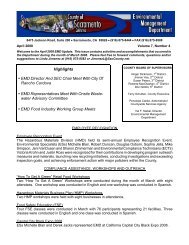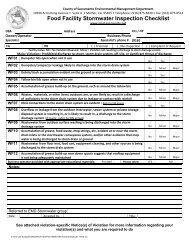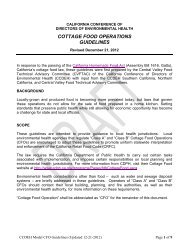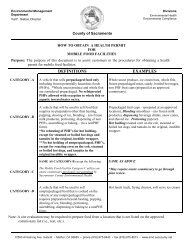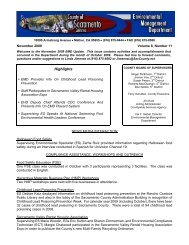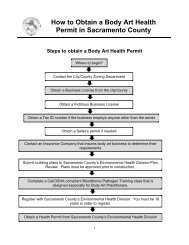California Water Well Standards, DWR Bulletin 74 ... - County of Glenn
California Water Well Standards, DWR Bulletin 74 ... - County of Glenn
California Water Well Standards, DWR Bulletin 74 ... - County of Glenn
- No tags were found...
You also want an ePaper? Increase the reach of your titles
YUMPU automatically turns print PDFs into web optimized ePapers that Google loves.
GENERAL INTRODUCTIONImproperly constructed, altered, maintained, or destroyed wells are a potential pathway for introducing poorquality water, pollutants, and contaminants to good-quality ground water. The potential for ground waterquality degradation increases as the number <strong>of</strong> wells and borings in an area increases.Improperly constructed, altered, maintained, or destroyed wells can facilitate ground water quality degradationby allowing:.Pollutants,contaminants, and water to enter a well bore or casing;.Poor quality surface and subsurface water, pollutants, and contaminants to move between the casing andborehole wall;.Poor quality ground water, pollutants, and contaminants to move from one stratum or aquifer to another;and,.Thewell bore to be used for illegal waste disposal.Permanently inactive or "abandoned" wells that have not been properly destroyed pose a serious threat towater quality. They are frequently forgotten and become dilapidated with time, and thus can become conduitsfor ground water quality degradation. In addition, humans and animals can fall into wells left open at thesurface.History <strong>of</strong> <strong>DWR</strong> <strong>Standards</strong>The Department <strong>of</strong> <strong>Water</strong> Resources has responsibility for developing standards for wells for the protection<strong>of</strong> water quality under <strong>California</strong> <strong>Water</strong> Code Section 231. <strong>Water</strong> Code Section 231 was enacted in 1949.Statewide standards for water wells were first formally published in 1968 as <strong>DWR</strong> <strong>Bulletin</strong> <strong>74</strong>, <strong>Water</strong> <strong>Well</strong><strong>Standards</strong>: State <strong>of</strong> <strong>California</strong>. <strong>Standards</strong> for cathodic protection wells followed in 1973 as <strong>Bulletin</strong> <strong>74</strong>-1,Cathodic Protection <strong>Well</strong> <strong>Standards</strong>: State <strong>of</strong> <strong>California</strong>. <strong>Bulletin</strong>s <strong>74</strong> and <strong>74</strong>-1 are now out <strong>of</strong> print.A revised edition <strong>of</strong> <strong>Bulletin</strong> <strong>74</strong> was published in 1981 as <strong>Bulletin</strong> <strong>74</strong>-81 <strong>Water</strong> <strong>Well</strong> <strong>Standards</strong>: State <strong>of</strong><strong>California</strong>. <strong>Bulletin</strong> <strong>74</strong>-81 is enclosed in the back cover <strong>of</strong> this report.The law for establishing and implementing well standards was changed significantly in 1986 by Assembly Bill3127 and Senate Bill 1817 (now Chapters 1152 and 1373, Statutes <strong>of</strong> 1986). Assembly Bill 3127 (<strong>Water</strong> CodeSection 13801) requires that:(1) By September 1, 1989, the State <strong>Water</strong> Resources Control Board adopt a model well ordinanceimplementing <strong>DWR</strong> standards.(2) By January 15, 1990, all counties and cities, and water agencies where appropriate, adopt a wellordinance that meets or exceeds <strong>DWR</strong> well standards.(3) By February 15, 1990, the Board's model ordinance is to be enforced by any county, city, or water agencyfailing to adopt a well ordinance.Senate Bill I8I? amended the <strong>Water</strong> Code to specifically include monitoring wells. It was previously assumedthat monitoring wells were included in the collective term "well" used in the law.-3-



